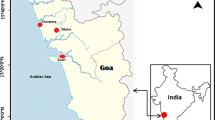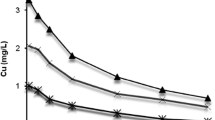Abstract
To assess the potential of two molluscs species as bioindicators of Cd and Hg pollution in aquatic ecosystems, a laboratory study was conducted on the short-lived gastropod Viviparus georgianus and the pelecypod Elliptio complanata. Using analysis of covariance (ANCOVA), we have evaluated the contribution of the aqueous trace metal concentration, the size of the molluscs and the exposure time to explain the Cd and Hg body concentration. Results show that all the parameters analyzed have a significant effect on Cd and Hg body variation in the gastropod except for the time of exposure and the interaction time of exposure-height of the individuals. The same results are observed for the pelecypod, except that the length of the individuals has not a significant influence on Cd and Hg variation. The major part of the variability of the body metal concentration seems to be explained by these three parameters: the water metal concentration, the interaction of water metal concentration with time of exposure and the interaction of water metal concentration with time of exposure and the size of the individuals.
Résumé
Afin d'évaluer le potential de deux espèces de mollusques à titre de bioindicateur de la pollution par le Cd et le Hg, une étude de laboratoire a été réalisée sur le gastéropode Vviparus georgianus et le pélécypode Elliptio complanata. L'analyse de covariance (ANCOVA) a été utilisée pour évaluer Feffet de la concentration métallique dans l'eau, le temps d'exposition et la taille des individus sur les teneurs en Cd et Hg dans les tissus des deux organismes étudiés. Les résultats ont démontré que l'ensemble des parameters analysés ont un effet significatif sur la concentration tissulaire en Cd et Hg chez le gastéropode, excepté le temps d'exposition et l'interaction temps d'exposition-hauteur des individus. Les mêmes résultats ont été observés chez le pélécypode à l'exception de la longueur des spécimens qui n'a pas d'effet significatif sur les teneurs en Cd et Hg. Uensemble des variations concernant les teneurs en Cd et Hg dans les tissus des organismes étudiés semble être expliqué par la concentration métallique dans l'eau, l'interaction concentration métallique dans l'eau-temps d'exposition et l'interaction concentration métallique dans l'eau-temps d'exposition-taille des individus.
Similar content being viewed by others
References
American Public Health Association (APHA): 1989, Standard Methods for Examination of Water and Wastewater, APHA, Washington, D.C.
Arnon, D.I.: 1949, Plant. Physiol. 24, l.
Balogh, K. V. and Salanki, J.: 1984, Water Res. 18, 1381.
Breittmayer, J. P. Guido, R. and Turner, S.: 1980, Chemosphere 9, 725.
Breittmayer, J. P. and Zsurger, N. V.: 1983, Rev. Int. Océanogr Méd. 70–71, 87.
Browne, R. A.: 1978, Ecology 59(4), 742.
Campbell, J. and Evans, R. D.: 1991, Arch. Environ. Contam. Toxicol. 20, 125.
Cossa, D.: 1989, Oceanol. Acta 12(4), 417.
Davies, I. M. and Pirie, J. M.: 1978, Mar. Pollut. Bull. 9, 128.
Foe, C. and Knight, A.: 1985, Hydrobiologia 127, 105.
Graney, R. L. Cherry, D. S. and Cairns, J.: 1984, Water Res. 18, 833.
Hemelraad, J. Holwerda, D. A. and Zandee, D. I.: 1986, Arch. Environ. Contam. Toxicol. 15, 1.
Hinch, S. G. and Stephenson, L. A.: 1987, Can. J. Zool. 65, 2436.
Hinch, S. G. and Green, R.: 1989, Can. J. Zool. 67, 855.
Kilgour, B. W.: 1991, Bull. Environ. Contam. Toxicol. 47, 70.
Lobel, P. B., Bajdik, C. D., Belkhode, S. P., Kackson, S. E. and Longerich, H. P.: 1991, Arch. Environ. Contam. Toxicol. 21, 409.
Manly, R. and George, O.: 1977, Environ. Pollut. 14, 139.
Newman, M. C. and McIntosh, A. W.: 1983, Arch. Environ. Contam. Toxicol. 12(1), 25.
Phillips, D. J. H.: 1977, Environ. Pollut. 13, 281.
Pip, E.: 1992, J. Moll. Stud. 58, 199.
Tessier, L., Vaillancourt, G. and Pazdemik, L.: 1994, Environ. Pollut. 85, 271.
Thain, J. E.: 1984, Mar. Environ. Res. 12, 285.
Author information
Authors and Affiliations
Rights and permissions
About this article
Cite this article
Tessier, L., Vaillancourt, G. & Pazdernik, L. Laboratory study of cd and hg uptake by two freshwater molluscs in relation to concentration, age and exposure time. Water Air Soil Pollut 86, 347–357 (1996). https://doi.org/10.1007/BF00279166
Received:
Accepted:
Issue Date:
DOI: https://doi.org/10.1007/BF00279166




